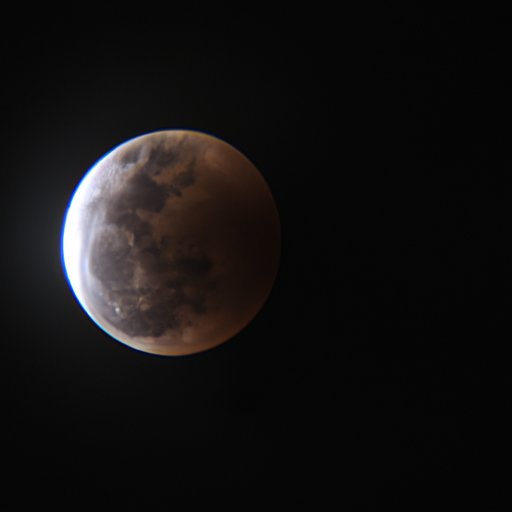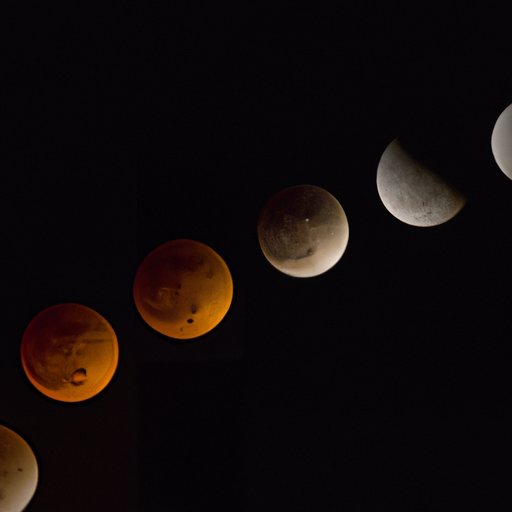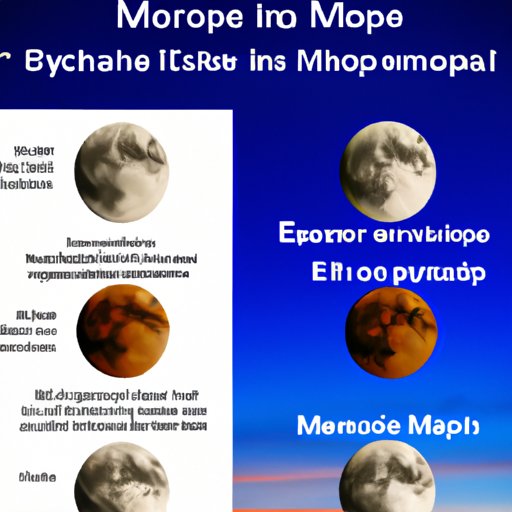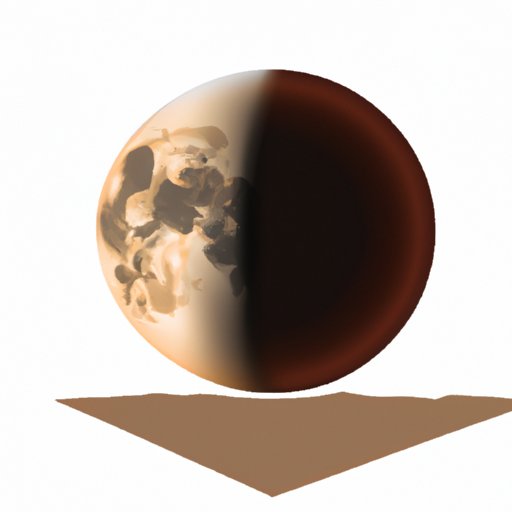Introduction
A lunar eclipse is a natural phenomenon that occurs when the Moon passes through the Earth’s shadow. During a lunar eclipse, the Earth blocks the light from the Sun, causing the Moon to appear dark in the night sky. This article will explore the science behind lunar eclipses, detailing how they are created, what causes them and how to observe them.

Exploring the Science Behind Lunar Eclipses
Before we dive into the specifics of a lunar eclipse, it’s important to understand some basic astronomical facts about the moon. The moon is the Earth’s only natural satellite, orbiting our planet at an average distance of 238,855 miles. It rotates once every 27 days, reflecting the light of the sun and creating its characteristic phases—from new moon to full moon.
Now that we have a better understanding of the moon’s orbit and rotation, let’s explore how a lunar eclipse works. A lunar eclipse occurs when the moon passes through the Earth’s shadow, which is composed of two parts: the umbra and the penumbra. The umbra is the darkest part of the shadow, where the light from the sun is completely blocked by the Earth. The penumbra is the outer part of the shadow, where the light from the sun is partially blocked by the Earth.
During a lunar eclipse, the sun, moon and Earth must be precisely aligned with one another. This alignment allows the Earth’s shadow to fall on the moon, making it appear darker in the night sky. It is this alignment of the three celestial bodies that makes a lunar eclipse possible.
An Astronomer’s Guide to Lunar Eclipses
Now that we know how a lunar eclipse is created, let’s take a closer look at its characteristics. A lunar eclipse can last up to 3 hours and 40 minutes, although most are much shorter. They can also occur in different parts of the world, depending on their location relative to the moon’s path.
There are three types of lunar eclipses: total, partial and penumbral. During a total lunar eclipse, the entire moon passes through the umbra, making it appear dark in the night sky. During a partial lunar eclipse, only part of the moon passes through the umbra, while the rest passes through the penumbra. During a penumbral lunar eclipse, the moon passes through the penumbra but not the umbra.
The duration of a lunar eclipse depends on its type. Total lunar eclipses can last up to 3 hours and 40 minutes, while partial and penumbral eclipses usually last between 1 and 2 hours.
How a Lunar Eclipse is Created
Now that we know the basics of a lunar eclipse, let’s take a closer look at how it is created. As mentioned earlier, a lunar eclipse occurs when the sun, moon and Earth are in precise alignment with one another. This alignment allows the Earth’s shadow to fall on the moon, making it appear darker in the night sky.
To understand the mechanics of a lunar eclipse, it’s important to understand the Earth’s shadow. The Earth’s shadow is composed of two parts: the umbra and the penumbra. The umbra is the darkest part of the shadow, where the light from the sun is completely blocked by the Earth. The penumbra is the outer part of the shadow, where the light from the sun is partially blocked by the Earth.
During a lunar eclipse, the moon passes through the Earth’s shadow, making it appear darker in the night sky. Depending on the alignment of the sun, moon and Earth, the moon may pass through the umbra, the penumbra or both. The visibility of a lunar eclipse also depends on various factors, such as the size of the Earth’s shadow, the position of the moon relative to the umbra and penumbra and the amount of dust and clouds in the atmosphere.

A Detailed Overview of Lunar Eclipses
Now that we know how a lunar eclipse is created, let’s take a closer look at what happens during one. A lunar eclipse has four distinct stages: partial eclipse, total eclipse, maximum eclipse and partial eclipse. During the partial eclipse stage, the moon begins to enter the Earth’s shadow, making it appear darker in the night sky. During the total eclipse stage, the moon is completely covered by the Earth’s shadow, making it appear very dark in the night sky.
During the maximum eclipse stage, the moon is at the deepest point in the Earth’s shadow, making it appear very dark in the night sky. Finally, during the partial eclipse stage, the moon begins to exit the Earth’s shadow, gradually becoming brighter in the night sky.
Observing a lunar eclipse is a unique experience. To get the best view, find a spot away from light pollution and look for the moon in the night sky. As the eclipse progresses, you’ll be able to see the moon gradually become darker and brighter again.
What Causes a Lunar Eclipse?
Now that we know how a lunar eclipse is created and observed, let’s take a closer look at what causes one. A lunar eclipse is caused by the alignment of the sun, moon and Earth. During a lunar eclipse, the Earth is positioned directly between the sun and moon, blocking the light from the sun and casting its shadow on the moon.
The timing of a lunar eclipse is determined by the Earth’s rotation and orbit around the sun. The Earth rotates once every 24 hours, and orbits the sun once every 365 days. The alignment of the sun, moon and Earth must be precise for a lunar eclipse to occur, and this alignment only happens a few times each year.
Step-by-Step Explanation of a Lunar Eclipse
Now that we know what causes a lunar eclipse, let’s take a look at the steps involved in one. A lunar eclipse follows a predictable pattern, beginning with the partial eclipse stage and ending with the partial eclipse stage. During the partial eclipse stage, the moon begins to enter the Earth’s shadow, making it appear darker in the night sky. During the total eclipse stage, the moon is completely covered by the Earth’s shadow, making it appear very dark in the night sky.
During the maximum eclipse stage, the moon is at the deepest point in the Earth’s shadow, making it appear very dark in the night sky. Finally, during the partial eclipse stage, the moon begins to exit the Earth’s shadow, gradually becoming brighter in the night sky.

Answering Common Questions about Lunar Eclipses
Finally, let’s answer some of the most commonly asked questions about lunar eclipses. One of the most common questions is “How often do lunar eclipses happen?” The answer is that lunar eclipses occur a few times each year, depending on the alignment of the sun, moon and Earth.
Another common question is “Can I see a lunar eclipse from my location?” The answer depends on your location relative to the moon’s path. If you are located within the path of the moon’s shadow, then you may be able to see the eclipse. However, if you are outside of the path of the moon’s shadow, then you will not be able to see the eclipse.
Conclusion
In conclusion, a lunar eclipse is a natural phenomenon that occurs when the moon passes through the Earth’s shadow. We explored the science behind lunar eclipses, detailing how they are created, what causes them and how to observe them. We also answered some of the most commonly asked questions about lunar eclipses.
(Note: Is this article not meeting your expectations? Do you have knowledge or insights to share? Unlock new opportunities and expand your reach by joining our authors team. Click Registration to join us and share your expertise with our readers.)
